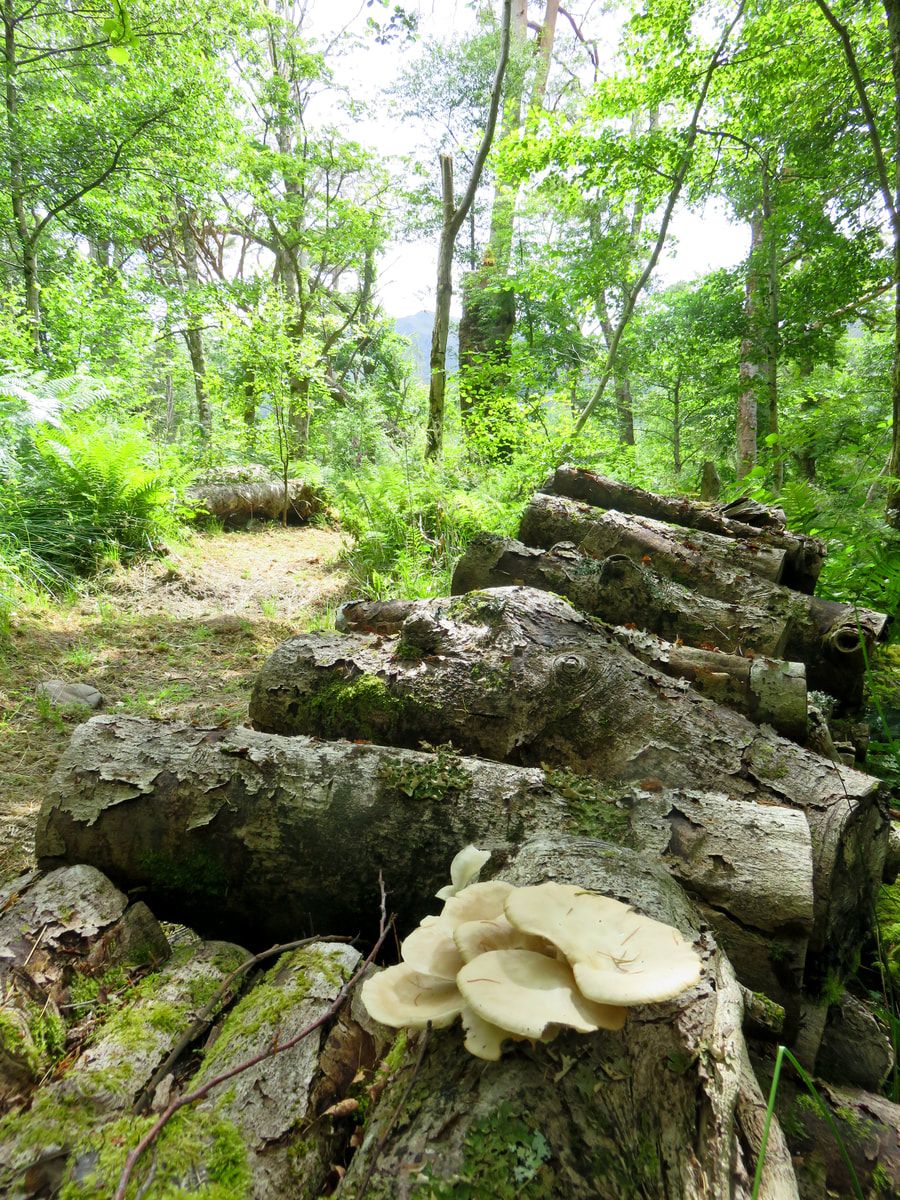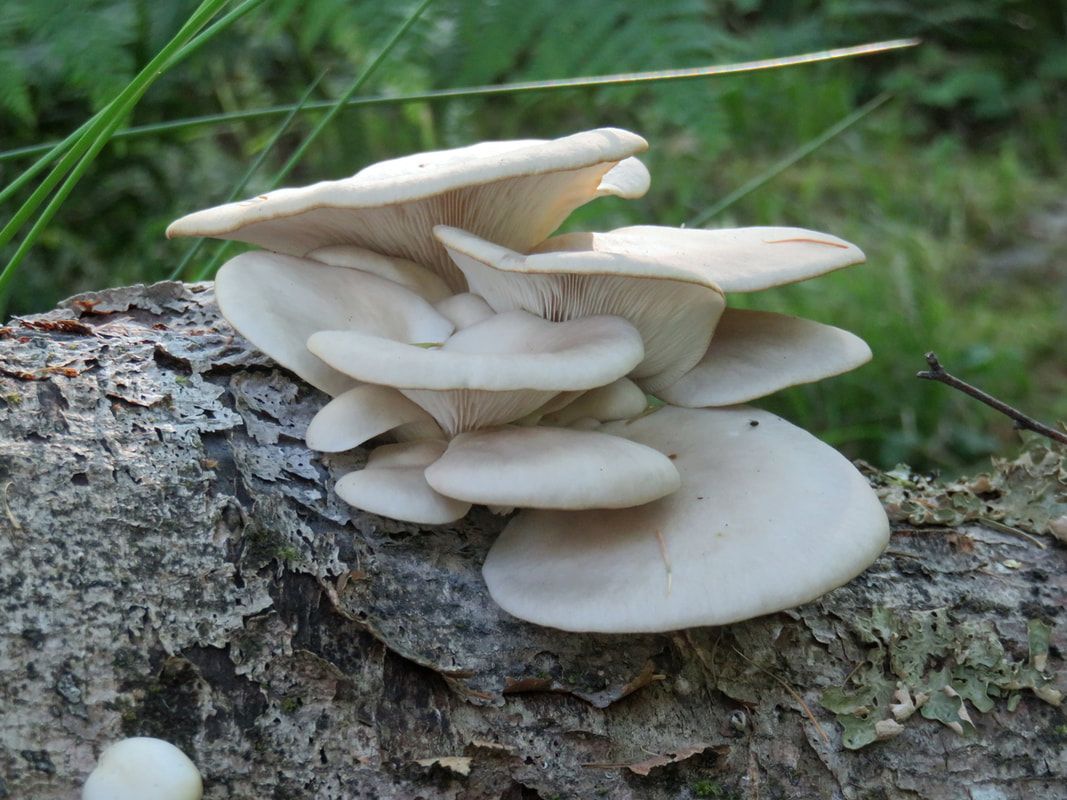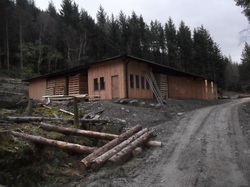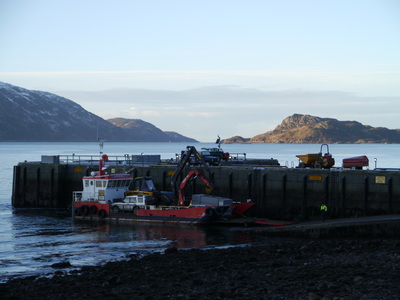|
by Finlay Greig Knoydart hosted the launch of a new strategic approach for Scotland’s rainforest last week aiming to improve the condition and health of the precious habitat.
The strategy, developed by Scottish Forestry, underlined the need to deliver community benefits including the creation of rural jobs, skills and training, health, and wellbeing. Rural Affairs Secretary Mairi Gougeon launched the paper in the shadow of old-growth oaks and hazel in Knoydart’s woodland. She said: “Scotland’s rainforest is a treasured natural asset. Restoring and expanding our rainforest will contribute to our nature positive net zero ambitions and conserve this iconic ecosystem for the future, as well as securing jobs and enabling green skills development. “There is fantastic work already being carried out to restore and expand the rainforest here and by a great number of organisations and individuals working across the whole rainforest zone. Much of this has importantly involved communities, such as the case in Knoydart. “This new strategic approach published today aims to build on this tremendous work and identify practical steps that the Scottish Government and its partners can take to help rejuvenate Scotland’s rainforest.” The Alliance for Scotland’s Rainforest have recently highlighted Knoydart as an “excellent example of community-led, landscape-scale rainforest restoration and expansion”. The Knoydart Foundation and Knoydart Forest Trust have taken key steps in the past three decades to improve the habitat, including; the near eradication of invasive non-native species Rhododendron ponticum, effective deer management, the restructuring of non-native conifer plantation woodland which surrounds the village of Inverie and, expanding and linking woodland habitats on the peninsula Lorna Schofield of the Knoydart Forest Trust celebrated the connection and interdependence of community and the land in regenerating the rainforest habitat and the community. She said: “A lot of our work on Knoydart’s rainforest has concentrated on the eradication of invasive rhododendron. This work has spanned 25 years and is ongoing. It has mostly involved the Trust’s staff, backed up by volunteers, local residents and some contractors, and funded through a succession of forestry grants. “Twenty-five years of community land ownership in Knoydart strongly demonstrates the benefits of long-term community led rainforest regeneration.” Due to high levels of rainfall and relatively mild temperatures Scotland’s temperate rainforests host a variety of rare lichens, bryophytes and ferns. Some of the highest quality examples of this habitat can be found on Knoydart. Speaking at the launch of the strategy on July 16, Julie Stoneman of Alliance for Scotland’s Rainforest celebrated the threatened habitat getting the “attention it deserves”. She said: “Scottish Forestry’s refreshed approach to collaborative, landscape-scale, long term, and community-centric rainforest restoration is key to the future of this internationally important habitat, building on the work of ASR’s partners and rainforest communities.” Image credit: Ian Collier, Scottish Forestry
0 Comments
The project is funded by the Natural Lottery Heritage Fund through the Facility for Investment Ready Nature Scotland (FIRNS) programme.
The Project Manager – Knoydart Credit: A partnership of nature and community is a full-time post for a fixed term and is suitable for hybrid working. For more details click on the links below. The Knoydart community (around 115 people), through the Knoydart Foundation, are custodians of 7,000 hectares of land, that’s roughly 0.1% of Scotland. The community is keenly aware of the responsibility it has to look after the land to maximise the potential of that land and assets to bring environmental, social and economic benefits to the local and wider community. Since 1999 the Knoydart Forest Trust (KFT) has been working to regenerate the woodland on Knoydart through community land ownership and management, and working with other landowners on the peninsula via its trading subsidiary, Wood Knoydart. The shared long-term vision is to link woodland habitats across the peninsula from Loch Nevis to Loch Hourn, creating stepping stones for plants and wildlife to support biodiversity, the resilience of the habitat and address climate change crisis, as well as provide many other social and economic benefits. The past year has seen significant progress in realising this vision with 64 hectares of new woodland created on community owned land and over 80 hectares on privately owned land plus restock planting – a total of 152,000 trees planted. Planting this number of trees as a tiny organisation with a core of 4 employees, on a remote peninsula with boat only access, over the dark, wet & windy winter on the north west coast of Scotland on some very rough terrain has not been without its challenges but with the help of a hardy bunch of folk it all came together. Finding enough people to plant the trees and who are willing and able to cope with the challenges of remote tree planting in an already remote location and finding a way to house them is one of the biggest hurdles. Like many rural communities the shortage of available affordable accommodation is an ongoing issue and can really impact on what can be achieved. The work at one of the sites, Ben’s Wood at Croulin, the challenge was heightened by its very remote (even by Knoydart standards) location. The planning and logistics for the planting was taken to another level (and the hardiness of the tree planters!) due to the location and it not being feasible to travel daily to the site. All the trees, the digger for mounding, food, firewood, bell tents, a big ex-army tent, a wee woodburning stove, tables, chairs, pots, plates etc, were transported round to Croulin on the Spanish John, a local landing craft, with the tree planting squad. The planting team setup camp and worked for 10day stints, returning to Inverie for long weekends by walking for an hour and a half to the nearest road and getting picked up. The generous hospitality of the owners of the only house at Croulin was very much appreciated and helped to make things a good bit easier. The result – job done - 37,000 trees planted by the local team of planters supplemented by a few extras that were drafted in from around the country. What’s next? The rest of the planting, 60,000 trees, at Ben’s Wood is due to kick off in September and fencing work on a new 58hectare woodland on community land will start in the autumn with planting planned for the start of 2023. There’s also work for a neighbouring landowner to establish a big area of new woodland. So, the search for tree planters and accommodation resumes. If you or anyone you know is an experienced tree planter and would be interested in helping Knoydart Forest Trust to restore the woodland habitat on Knoydart please do get in touch for a chat.
(Main photo: Danny & Trisha celebrating planting the last tree of the season at Ben's Wood (photo credit: Trisha Birch)) Work has been ongoing for a push to eradicate Rhododendron ponticum from the peninsula. R. ponticum, loved by some and stunning in bloom, is a highly invasive, non-native species widely introduced over many areas of the UK. By the time of the community buyout in 1999 it had become a major threat to biodiversity, woodland resilience and regeneration on Knoydart. A monumental effort now spanning decades has massively reduced the once dominant population of R. ponticum and allowed native woodland communities to begin to recover and re-colonise. Critical to the success of the project has been the support from neighbouring landowners which has enabled us to work on a landscape scale. The initial clearance was done using the conventional method of cutting and subsequent spraying of regrowth in the following years, however seed sources still remained in the soil and where bushes had been missed, for example in compartments which were inaccessible due to windblow, and on privately owned land within the woods, which allowed R. ponticum to begin to re-colonise. Work this year aimed to remove these seed sources, communicating with neighbouring landowners where necessary, and remove any regeneration found in the woodlands. As most of the plants were not yet mature, the method that we decided was best for removal was hand pulling. This ensures that all roots are removed so that the bushes won’t regenerate, reducing maintenance costs in the future. This meant that we had to manually search and remove all rhododendrons across the 257 hectares of woodland. The preparatory work for the current “rhodie bash” started last year, with surveys carried out as part of an application for Forestry Grant Scheme funding to determine the distribution and density of R. ponticum within the woods. This was done in tandem with the cutting of racks in the compartments of the woods which are severely affected by windblow to facilitate access and to serve as markers to ensure that all the ground was covered when searching for bushes. In addition to the Forestry Grant Scheme, funding from the Heritage Lottery Fund has been secured which will enable us to develop a citizen science project with the aim of increasing the communities understanding of the detrimental effects that R. ponticum has on the local ecosystem, and encouraging local engagement in the task of removing the species from the peninsula. The small population on Knoydart meant that it was difficult to source a team of workers locally that was large enough to deal with the task. An advertisement on Facebook (which attracted a large number of applicants), and word of mouth allowed us to assemble a team of six amazing and dedicated “rhodie bashers” who were eager to face the west coast winter. The team was divided into squads led by employees of the Knoydart Forest Trust. In addition to constraints imposed by private land ownership within the woodland, additional factors affected our task. Almost all watercourses in the woodlands around Inverie feed into the domestic water supplies of the village. This meant that the use of pesticides when clearing the rhododendrons was avoided unless it was absolutely necessary.
The hunt does not stop here, there are still outlying mature plants on the peninsula that will be removed in weeks to come. This clearance will hopefully be one of the last and one day, Rhododendron ponticum will finally be eradicated from the Knoydart peninsula. Work on the project stopped in March due to Covid 19, however the community is enriched by the squad who have remained on Knoydart and have continued with other important community work. by Danny Gorman & Josh Gilbert Twenty years ago today KFT came into being, born out of the vision, enthusiasm and hard work of a group of residents at a time when the ownership of 17,000 acres of Knoydart Estate was uncertain and the fragility of the land and community was sorely felt. Three days later the community successfully also became the custodians of the Estate. The last 20 years have seen stability, resilience and diversity return to the woodlands and the community. Here's a snapshot of those 20 years of KFT in 20 pictures... Looking forward to the next 20!
by Ian DowKFT Forester & fungi lover  Sycamore branchwood stack, Policy Woods Knoydart Sycamore branchwood stack, Policy Woods Knoydart If a tree falls or blow over in the woods there is a decision to be made on how best to deal with it - do we extract the timber for milling and firewood or leave it where it is to provide ecological benefits? Here's the story of how we decided to deal with a Sycamore that blew over in the Policy Woods in 2016. At the time we were aware that the tree had already been colonised by a variety of Pleurotus ostreatus (Oyster mushroom). So we decided to log and stack the crown so that the branch wood could remain in the woodlands to create an easily accessible wild harvest of Oyster mushrooms, a common edible mushroom, at ground level (often, and in the case of this tree, Oyster brackets are found out of reach high up in the tree). We then winched the main stem (of considerable girth, seen in the background of image) and rootplate back up to the vertical with the objective of creating standing deadwood habitat.  Oyster mushrooms colonising Sycamore Oyster mushrooms colonising Sycamore The story of this Sycamore tree offers a small window into the potential that foresters have to guide and manipulate their timber resource in non traditional ways that can benefit woodland ecology, increase biodiversity, accelerate soil creation and encourage people out to enjoy and make use of their woodland resource. SAFETY NOTE: There are a few closely related species that can be hard to distinguish from oysters. So it's helpful to bring someone knowledgeable when searching for them in the woods. by Angela Williamsone of Wood Knoydart's first stool makers At home the mention of doing a stool making course led to some raised eye brows - and with good reason. Whilst my home may show a love of wooden objects, my ability to actually make anything probably ranks alongside my DIY skills. Non-existent. However, my lack of ability probably says more about a lack of confidence and opportunity than anything else. So, when I had the opportunity to go on a Wood Knoydart stool making workshop, it was time to put lack of confidence to one side.
The day was wonderful. It should probably be classed as therapy as much as woodwork. In fact, I could happily have spent the whole day on the saw-horse and not worried about making a stool; I found the motion totally mesmerising. That said, I was really proud as my little 3-legged stool became a reality and all the different processes came into place. I even managed not to create a first aid incident with the specialist knives. What more can you ask for. Good company, learn new skills -and finish the day with the rare satisfaction of having made something that you can cherish and use. To be fair, I think my cats are doing the cherishing. It's now their new resting place - and great for claw sharpening! So, thank you Lorna, Kristy and Johann. Thank you for sharing your skills. Can I come again and make a different one?  With a few exceptions it is probably fair to say that nobody thinks that fences are beautiful and they are definitely not cheap. So why do we put up fences? The reason is that we want to increase the amount of woodland cover on Knoydart and here’s why:
To make this happen due to the density of deer on the ground and the lack of tree seed source we have to put up temporary fencing and plant trees. When the woodland is resilient enough the fences can be removed dependent on the deer density levels. The relationship between trees and deer is dynamic – in the long term the increase in woodland cover make a better habitat for deer but only if a balance being achieved between the impact of deer on the land and how resilience of the woodland. Deer management in Scotland is under review with the negative impacts of inappropriate deer numbers being recognised. The West Knoydart Deer Management Group is working with neighbouring landowners to balance multiple land management objectives with the Scottish Government policy of “public interest” in relation to deer management. Timescale in forestry terms is very different to that of us humans. Much of the benefit of the woodland creation and regeneration happening now will not be seen until outwith, at least some of, our lifetimes. KFT look forward to a day when woodland regeneration and creation can happen without temporary fencing, however that day is not here yet. We believe that the long term benefits achieved by creating more woodland far outweigh the short term disadvantages of temporary fencing. We work hard to carefully design new woodlands to minimise the impact of fences on the landscape and access. By improving visitor and local information we think that rather than being put off by temporary fencing that visitors, and hopefully the majority of the community, will value and support the reasons for them being there and the long term benefits that they will bring.  Here's a quick update on what we've been up to since our last entry: 300,000 TREES - we've been doing some sums and worked out that since 1999 KFT has planted over 300,000 trees. This goes a long way in helping achieve the shared vision of linking up the woodland habitat on the peninsula from Loch Nevis to Loch Hourn. And we will be planting more next Spring in a new woodland at The White Gate (above Sawmill Wood). WOODFUEL - the woodfuel shed is well and truly up and running - 2015/16 has been a record firewood sales year with 170m3 sold to customers in Knoydart and Mallaig. We converted our firewood processor to run on electricity from our community hydro electric supply making our firewood even more carbon friendly! PHASE 2 FELLING - as part of the restructuring of Inverie Woods the second harvesting operation took place in 2015. This work is essential to remove unstable blocks of conifer monoculture and to clear significant windblow and in this instance to protect our community electricity powerline.. 3,500 tons of timber was exported by boat and we kept 1,000 tons to meet local woodfuel and timber needs.. The area will be replanted in 2016/17 with a mix of tree species. FOREST PLAN REVIEW - We are in the process of reviewing our Woodland Management and Forest Plan and have hosted a number of community events throughout the year - guest speakers, walks & talks, workshops, scoping meeting - and issued a questionnaire to make sure that the views and thoughts of the community are reflected in the renewed plans. Alot of interesting and exciting ideas have come out of this and we look forward to finalising the plans for the next 20 years by November. and then implementing them.
 Knoydart Forest Trust - Wood Fuel Shed Knoydart Forest Trust - Wood Fuel Shed If you do Facebook - please have a look here. Sometimes we forget to post up all that we are doing. Sometimes we just don't have time !!! We've been launching Wood Knoydart, organising volunteer tree planting, finishing off the wood fuel shed , ............................. Grant Holroyd, our Head Forester has been away on a study trip to Romania recently . There are some great photos from that tour on our FB page. Have a look - stunning places he visited. |
KFT NEWSKeeping you informed with what's going on ...... Archives
August 2022
Categories
All
|














 RSS Feed
RSS Feed
